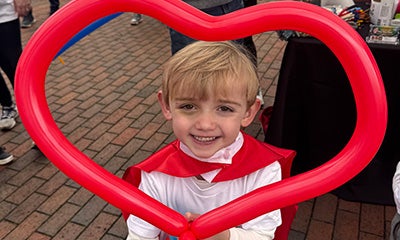At a routine OBGYN appointment, Brandon and Emily Tinsley were told their son would one day have to undergo open-heart surgery. “When I was told, I was afraid we would never be able to bring our baby home from the hospital,” Emily said. “All I had ever wanted was to be a mother.”
Quinn Tinsley’s tachycardia was detected at 24 weeks, and he was diagnosed with double inlet left ventricle, transposition of the great arteries and coarctation of the aorta. At Emily’s 32-week appointment, Quinn’s heart rate was 240 beats per minute, and he was diagnosed with supraventricular tachycardia. Emily was prescribed medication to lower his heart rate without damaging her own, allowing her to carry to term.
When Emily’s inducement date arrived, she was surrounded by a team of OBs and pediatric specialists who were ready to start care immediately. At 6 days old, Quinn experienced his first of three surgeries. The Norwood procedure is an open-heart surgery needed when one of the ventricles and aorta are too small to pump blood to the body. It uses the adequately sized ventricle and the reconstructed larger aorta to deliver blood to the rest of the body.
After the procedure, Quinn’s care team, who Emily says has “become like family,” helped the family understand how to care for him at home. “We had to try to live our normal life,” Emily explained. “There are many things outside of the heart that are affected, such as his progression of walking, and he had a feeding tube until he was 5 years old.”
Children with hypoplastic ventricle need at least two more surgeries: the Glenn procedure and the Fontan procedure. At 6 months, Quinn had his second operation. During the Glenn procedure, the superior vena cava which normally empties into the right atrium is instead diverted to the right pulmonary artery. At 6 years old, Quinn underwent his third open-heart surgery, the Fontan procedure which connects the inferior vena cava to the pulmonary arteries with a plastic tube, allowing blood from the body to flow to the lungs without passing through the heart's right side.
Just six weeks after the Fontan procedure, Quinn returned to school. Three months after his procedure, Quinn came home with exciting news for his mom. That day, he had been able to run with his friends at recess. “Now I run into teachers who admit they never get onto him for running in the hallway because it’s such a blessing compared to when he was unable to walk long distances,” Emily said. “Seeing his excitement over something that most kids take for granted was so heartwarming that I was overwhelmed.”
Quinn loves school, his classmates and the school nurse. He is currently taking horse-riding lessons and plans to start baseball in the spring.











